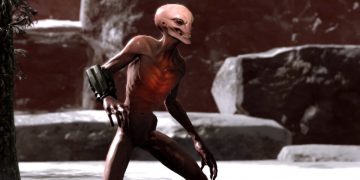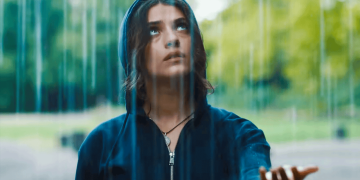This article contains spoilers for the Until Dawn movie.
I’ve been pondering the challenge of adapting Until Dawn into a movie. Supermassive Games crafted an interactive horror experience, essentially making a 10-hour film with choices that influence the story—a remarkable feat penned by indie horror veterans Larry Fessenden and Graham Reznick. Translating this nuanced narrative into a movie without losing its essence is no easy task. When Sony announced their intention to release an Until Dawn film, I was skeptical, and after watching it, I still find myself puzzled.
The film, directed by David F. Sandberg, strays from what makes the game so compelling.
Writers Gary Dauberman and Blair Butler aimed to create a movie true to its title. “Until Dawn” now unfolds as a time-loop horror, where five young adults must survive being hunted until the break of dawn. If a character dies, they reawaken as soon as an ominous hourglass runs out. Too many deaths turn them into wendigos, victims of Dr. Alan J. Hill’s twisted experiments. The central theme of a missing sibling remains—Clover, portrayed by Ella Rubin, is on a mission to find her sister. But this journey doesn’t take place on Blackwood Mountain and lacks the intricate choice-driven mechanics that define the game.
This isn’t Until Dawn.
In the game, death carries real weight. A single character’s demise can ripple through the narrative with significant consequences. There’s no going back—once a decision is made, it’s final. This tension is utterly lost in the film adaptation, where the stakes feel lower and outcomes less impactful.
Instead, the movie attempts a horror pastiche, reminiscent of Cabin in the Woods. Glore Valley is portrayed as a place where a mysterious force seems to orchestrate events, much like the “puppet masters” in Cabin. Dr. Hill plays the role of the omnipotent overseer, and characters often break the fourth wall, joking about horror tropes as various creatures emerge with each narrative reset. This chaotic mix doesn’t do justice to the game’s depth, where every choice pulls players deeper into its web.
At least the film includes wendigos, a connection to the game’s lore. In the game, a mining disaster in 1952 leads to cannibalism and the creation of these monstrous wendigos haunting Blackwood. The film’s plot involves Clover and her friends turning into wendigos due to Dr. Hill’s experiments, echoing his game office setting. Yet, this element is overshadowed by a generic slasher villain, witches, creepy masks, and explosive water—a disjointed collection of horror motifs unrelated to the original game’s straightforward creature-centric approach.
Peter Stormare reprises his role as Dr. Hill, a psychiatrist who challenges players with psychological tests affecting the game’s storyline. However, in the film, he starts as a gas station worker, later revealed to be the same Dr. Hill conducting gruesome experiments. This connection feels superficial, with Clover discovering her profile alongside Josh Washington’s, hinting at ties to the game’s well-known character.
While the movie presents Hill’s experiments that transform prisoners into wendigos, Clover manages to defeat Hill with relative ease—or so it seems.
As the film concludes, it returns to the decaying sanitarium where Dr. Hill self-destructs, and monitors reveal Blackwood’s lodge. Hill’s voice persists, implying he was merely a figment of Clover’s imagination. This twist feels like a prequel to the game’s storyline but diverges from its core events, setting up a potential sequel that might explore Josh’s quest for revenge—which remains questionable given the film’s internal logic.
Cheap Easter Eggs Aren’t Enough
Turning Dr. Hill into the main antagonist lacks finesse and feels like an uncooked attempt to draw from the game. The movie’s teases about Blackwood only add to the confusion, despite director Sandberg asserting it takes place post-game. This error in continuity makes one question why the film connects to Until Dawn—likely for the sake of leveraging a popular franchise.
In efforts to satisfy fans, the film includes nods to the game, albeit clumsily. Megan, played by Ji-young Yoo, leads a séance reminiscent of the game’s “hold your breath” instructions. A scene drenched in red light with a lurking wendigo recalls the game’s “Don’t Move” moments. But beyond these Easter eggs, the film doesn’t capture the essence of Supermassive’s inspiration or innovate as a standalone horror flick.
There are familiar elements: wendigo sounds from the game, Abe’s gruesome fate echoing Josh’s fake-out death, werewolf sketches hinting at The Quarry, and a basement radio suggesting survival themes. However, these references feel forced and fail to craft a cohesive vision.
While I’m open to spiritual successors, meaningful connection is essential. Unfortunately, Until Dawn as a movie misses capturing the intense, decision-driven dread that makes the game so addictive. It feels like an assemblage of horror ideas without depth, failing to bring Supermassive’s engaging narrative to life.
In the end, this adaptation squanders a golden chance to translate a beloved game into a compelling cinematic experience.









![[PS4] Review of Touhou Danmaku Kagura Phantasia Lost [PS4] Review of Touhou Danmaku Kagura Phantasia Lost](https://www.streamgamer.net/wp-content/uploads/2025/04/PS4-Review-of-Touhou-Danmaku-Kagura-Phantasia-Lost-360x180.jpg)





































